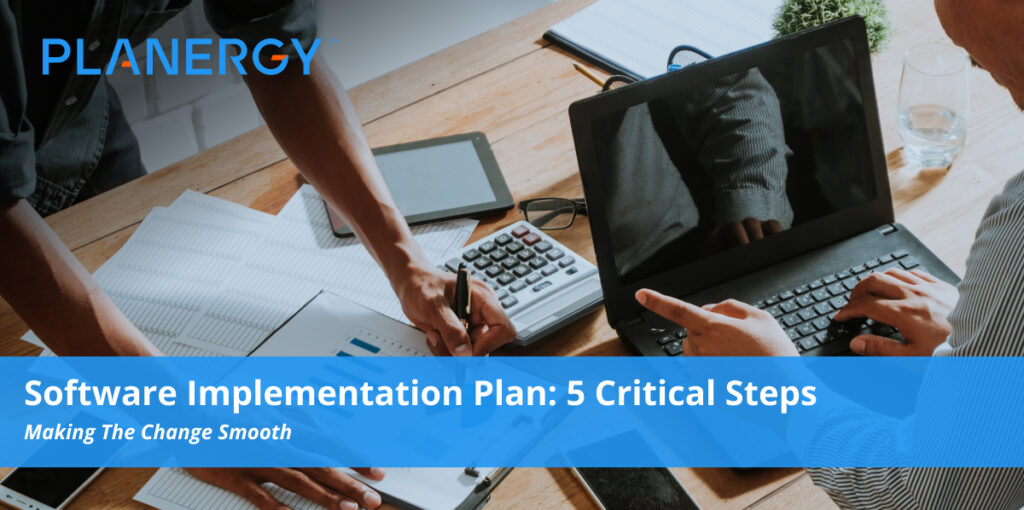In today’s market, small businesses have to compete against massive enterprises. One way to ensure they can keep up is by using the right tools and software to improve processes, optimize workflows, and increase productivity.
With a strong and efficient workflow in place for all major processes within a business, it’s possible to bring in more revenue in less time.
But if it were that easy, all businesses would be doing it. Finding the perfect platform for your business needs means you have to spend time and attention researching and possible options, and in most cases, a potentially significant financial investment.
Not only this, but people are creatures of habit and those habits are difficult to change. Your team may be used to doing things a certain way already and if that way works just fine for them, completely changing their business processes may cause their resistance to change.
This resistance could prove detrimental to the entire company.
The answer: Develop a plan first.
What is a Software Implementation Plan? Why Do You Need One?
A software implementation plan helps your company find and deploy the right software for your business needs.
Adopting new software is both time-consuming and can be costly in terms of finances and human resources. Without a plan in place before the process starts, it’s likely your software adoption will fail.
With a properly developed plan in place, you can avoid making hasty decisions, ensure the correct people are involved in the implementation, configure the system correctly and create a situation where employees can truly appreciate the full benefits the software has to offer while also providing adequate training.
For many businesses, adopting new software is a serious undertaking. If you mess up the implementation process, you’ll likely experience operational downtime which translates to lost revenue. On the other hand, if you take time to do your research and prepare ahead of time, your company can reap many benefits including, accelerated growth, cost savings, increase process efficiency, and improved visibility.
Software Implementation Plan: 5 Critical Steps
-
Step One: Build Your Business Case
Regardless of how big or small your business is, implementing new software isn’t something you do just because you feel like it.
While smaller businesses are more nimble than their larger competitors, mistakes of any kind can be costly and hurt any company, especially those on a limited budget.
Changes, such as upgrading current software or rolling out something new, are difficult for larger organizations too because the decision-making process becomes more complex as a company grows.
Research shows about 72% of senior executives think bad strategic decisions were “about as frequent as good ones or were the prevailing norm in their organization.”
How do you make your case?
- Consider your pain points: What challenges does your company face? What aspects need improvement? Talk to your staff and other relevant stakeholders to get answers. If you find that organizational efficiency is low and the company is losing revenue, focus efforts on that. Work to align your business objectives with your goals.
- Come up with a solution: Provide a detailed outline of, for example, how a new procurement software or new project management software could improve both team efficiency and productivity and why it’s critical to addressing the pain points you found.
- Conduct a cost and benefit analysis: The main reason to build a strong business case is to justify the investment. Analyze both the tangible and intangible costs along with the tangible and intangible gains the company stands to achieve with a successful implementation.
- Develop a timeline: Set reasonable time expectations around how long it takes to evaluate the software, implement the new system, and realize a return on the investment.
- Plan how you will manage change: Research indicates that 70% of organizational transformation programs fail. When it’s less risky to turn down a proposal, executives may have a harder time deciding to back it. Emphasize the cost of not addressing these pain points and make sure they understand that you know the risks as well as the steps you are going to take to steer clear of the same mistakes other organizations have made in the past. Change management is crucial for a smooth implementation phase.
-
Step Two: Choose the Right Vendor
Once you have the necessary support, you have to find the most suitable software vendor.
Whichever vendor you choose will be a strategic partner in your business so it’s important to take your time with the selection process.
Questions to ask as you narrow down your options include:
- What is it that you need? consider things such as features, price, cloud-based vs. on-premise vs. hybrid, and so on.
- How long has the vendor been in business? What are their credentials?
- Is the software scalable?
- Are there hidden costs?
- What do their customers have to say about them?
- Does the software integrate with the systems you already have in place?
- Does the vendor provide software training?
- Does the implementation cost include after-sales support?
- Are updates and upgrades cloud-based?
-
Step Three: Protect Against Scope Creep
If you’re not careful, the additional features different software options provide can scare you off track.
The software market offers a variety of options and customizations so preparing a needs document that outlines everything you’re looking for is critical when it comes to software evaluation.
Ideally, the document should give vendors a clear picture of what your organization’s specific needs are.
If you decide to set up the software that every available functionality or to customize all of its capability at one time, this is when scope creep happens. It’s a trap you’ll fall into that results in:
- Exponentially increase cost
- Stakeholders who lose interest
- Dragging out the implementation process
Projects rarely turn out exactly as they are expected to and software implementation is no different.
Changes during the project life cycle are a natural part of business, but to prevent scope creep, you must exercise a certain amount of control.
This is why it’s crucial that your implementation team applies project management best practices and that everyone works together to maximize software usage for their departments.
Regardless of the size of your team, a collaborative project management tool allows you to flush out your software implementation process plan. Some options include:
- Wrike: This is a good choice for project tracking features like Gantt charts and Kanban boards.
- Asana: This option is ideal for work or Centric features such as monitoring workload. it contains a number of built-in project templates and is user-friendly.
- Basecamp: This is an ideal choice for task prioritization, scheduling features, and document storage.
- Trello: This is a highly customizable platform that can be adapted to any workflow or process. Boards consist of cards, which can be assigned to individuals and moved around as needed. It integrates with a number of other tools, as well.
-
Step Four: Put Together an Implementation Team
Your software implementation team is crucial to project success. It can be as small as two people and can grow to as many people as you need to get the job done.
Typically, the more departments that need software, the bigger the implementation team becomes.
Each department should have a representative to function as the champion of the new software. This representative will also answer questions and help train their colleagues.
A team may include:
- Project owner: This is usually the head of a business or the department that is implementing the new system. It may also be a team of executives rather than a single person.
- Project manager: This is the person responsible for organizing the implementation process, including the budget.
- System administrator: This person oversees the system setup and technical administration
- Communication liaison: This person serves as the liaison between the project team and the end-users.
- Core department members: These are the people championing for the software, from each department in your organization.
Remember, the type of people you assigned to your implementation team reflects your commitment to the success of the initiative.
As such, it’s best to only include team members who are extremely talented, team-oriented, and equally committed to the project’s success.
-
Step Five: Put it to Use
The last thing you want is software the no one wants to use.
Of course, if you’re the boss, you can simply require your team to adopt the new system whether they like it or not.
But, if you do this, you should be prepared for pushback and an increase in employee dissatisfaction.
To avoid having to force your team to use the new software, there are a few things you can do:
- Prepare your team for the switch as early as you can: The sooner you let employees know about the change, the more accepting of it they will be.
- Assign a change manager: This person will spearhead the change and give employees a clear person to approach when it comes to questions, training, feedback, and other information.
- Clearly communicate benefits: When everyone understands the benefits the software offers them, you’re more likely to see higher adoption rates.
- Provide adequate training: For employees to use the software and reap the benefits, they must know how it operates.
- Continue to provide support: Even if the implementation process itself moves smoothly, it’s important to expect issues to arise especially during the early stages. To keep things running as smoothly as possible, make sure I help desk or tech support team is available to assist when needed.
You can use the ADKAR Change Model to ensure sustained adoption. Better yet, you can use this methodology to manage any kind of change within your organization.
- Awareness: Make sure everyone recognizes the problem.
- Desire: Incentivize using benefits and consequences
- Knowledge: Know how to create and maintain change
- Ability: Work to close skill gaps that restrict change
- Reinforcement: Measure and reward wins
While it may be tempting to use the same messaging and communication about the implementation process for each team within your organization, you’ll have better luck if you take the time to personalize all of it for each team.
Each team is likely to have different goals that the new system helps them to achieve. By honing in on these team-specific goals, you’ll be able to drive adoption.
It may take time to get everyone up to full speed with the new system and that’s okay.
As long as you continue to work better with the software every day, you’ll get there.
To support the long-term implementation of the new software, prioritize the capabilities to have to be mastered first. This helps influence training and provides benchmarks for your check-ins.
Focus efforts on continuous improvement. Training is a central part of this process.
After training staff on how to use the system, provide additional learning opportunities as needed.
When there is a major system update, consider hosting another training session to ensure everyone understands the changes.
For a successful software implementation, communication is key.
IT leaders, system champions, and implementation teams share the process, and all play a role in engagement and adoption.




